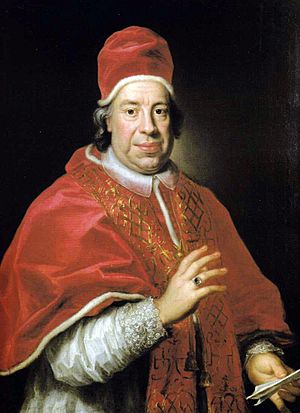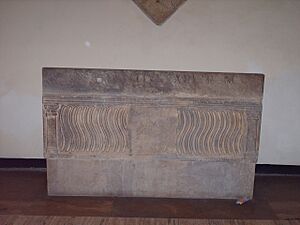Pope Innocent XIII facts for kids
Quick facts for kids Pope Innocent XIII |
|
|---|---|
| Bishop of Rome | |
 |
|
| Church | Catholic Church |
| Papacy began | 8 May 1721 |
| Papacy ended | 7 March 1724 |
| Predecessor | Clement XI |
| Successor | Benedict XIII |
| Orders | |
| Ordination | c. 1690 |
| Consecration | 16 June 1695 by Galeazzo Marescotti |
| Created Cardinal | 7 June 1706 |
| Personal details | |
| Birth name | Michelangelo dei Conti |
| Born | 13 May 1655 Poli, Lazio, Papal States |
| Died | 7 March 1724 (aged 68) Rome, Papal States |
| Previous post |
|
| Coat of arms | |
| Other Popes named Innocent | |
Pope Innocent XIII (born Michelangelo dei Conti) was the head of the Catholic Church and ruler of the Papal States from 1721 until his death in 1724. He was born on May 13, 1655, and died on March 7, 1724. He was the last pope to choose the name "Innocent."
Pope Innocent XIII wanted to make the Church better. He stopped wasteful spending and made new rules for being careful with money. He also tried to end nepotism, which is when leaders give special jobs or money to their relatives. He made a rule that future popes could not give land, jobs, or money to their family members. Many cardinals did not like this rule, as they hoped to help their own families if they became pope.
Contents
Biography
Early Life and Education
Michelangelo dei Conti was born on May 13, 1655, in Poli, a town near Rome. His father was Carlo II, Duke of Poli. His family, the Conti, were important landowners. Several popes, like Pope Innocent III and Pope Gregory IX, also came from this family. Michelangelo dei Conti even included his family's symbol in his official papal coat of arms.
He began his studies in Ancona and then went to the Collegio Romano in Rome, which was run by the Jesuits. Later, he studied at La Sapienza University. He earned a special degree in canon law (Church law) and civil law. After his studies, he became a priest.
Conti worked in several important government roles for the Church. He was a Referendary of the Apostolic Signatura in 1691. He then served as Governor of Ascoli until 1692. From 1692 to 1693, he was Governor of Campagna and Marittima. Finally, he was Governor of Viterbo from 1693 to 1695.
In 1695, Pope Innocent XII chose Conti to be the Titular Archbishop of Tarso. This meant he was an archbishop without a specific diocese to lead. He became a bishop on June 16, 1695, in Rome. Conti also worked as a papal ambassador, called a "nuncio," in both Switzerland and Portugal.
Becoming a Cardinal
On June 7, 1706, Pope Clement XI made Michelangelo dei Conti a cardinal. He became the Cardinal-Priest of Santi Quirico e Giulitta. He received his official church title on February 23, 1711.
From 1697 to 1710, he was the pope's ambassador to Portugal. During this time, he formed some negative opinions about the Jesuits. While in Portugal, he also saw early experiments with air balloons by a priest named Bartolomeu de Gusmão.
Conti was also made archbishop of Osimo in 1709. Later, in 1712, he became archbishop of Viterbo and Toscanella. He served as the leader of the group of cardinals, called the Camerlengo of the Sacred College of Cardinals, from 1716 to 1717. He left his position as archbishop in 1719 because he was ill.
Pontificate
Papal Election
After Pope Clement XI died in 1721, the cardinals met to choose a new pope. This meeting is called a conclave. It took 75 rounds of voting to finally choose Conti as the new pope. As other candidates lost support, the cardinals turned their attention to him. He was known for being smart, educated, pure, and kind. These qualities helped him get elected on May 8, 1721.
He chose the name Innocent XIII to honor Pope Innocent III. On May 18, he was officially crowned by Cardinal Benedetto Pamphili.
Key Actions as Pope
Pope Innocent XIII's time as pope was successful, but not many big events happened. He held two "consistories," which are meetings where the pope names new cardinals. He named three new cardinals on June 16, 1721, and July 16, 1721. One of these new cardinals was his own brother, Bernardo Maria.
A disagreement called the Chinese Rites controversy had started before he became pope. This argument was about whether Chinese traditions could be mixed with Catholic practices. Innocent XIII stopped the Jesuits from continuing their work in China. He also ordered that no new members should join the Jesuit order.
The Pope also helped the people of Venice and Malta in their fights against the Turks.
Like the pope before him, Innocent XIII supported James Francis Edward Stuart. Stuart was known as the "Old Pretender" because he claimed to be the rightful king of Britain. The pope gave him a lot of financial help. The pope's cousin, Francesco Maria Conti, even became a special assistant in James's small court in Rome.
Beatifications and Doctor of the Church
During his time as pope, Innocent XIII declared three people "blessed" (a step towards sainthood):
- John of Nepomuk (May 31, 1721)
- Dalmazio Moner (August 13, 1721)
- Andrea dei Conti (December 11, 1723)
On April 25, 1722, he also named Saint Isidore of Seville a Doctor of the Church. This is a special title given to saints who have made important contributions to Catholic theology or doctrine.
Death and Legacy
Pope Innocent XIII became ill in 1724. He had a hernia that he did not tell anyone about except his personal helper. At one point, it burst, causing pain and fever. He asked for the last religious rites and died on March 7, 1724, at 68 years old. His time as pope was not very eventful because he was often sick. He was buried in the grotto (a special underground area) at Saint Peter's Basilica.
Innocent XIII had suffered from a hernia for several months after becoming pope. He also had painful attacks from kidney stones. He did not help himself by eating too much and not exercising. He also felt very tired and slept a lot. In February 1724, his health got much worse. He could no longer get up and had swelling in his legs, which showed serious kidney problems. His doctors worried he might have heart failure.
On March 3, even though he was very sick, Innocent XIII still signed documents. On March 5, a doctor gave him medicine, but it made his hernia worse. He was in great pain. A serious infection quickly started, causing him to have a fever. Knowing he was dying, Innocent XIII asked for his last religious rites on March 6. His family came to see him. He signed a final change to his will that afternoon. That night, he received another religious rite. Pope Innocent XIII died around 11:00 PM (Rome time) on March 7.
Beatification Request
In 2005, on the 350th anniversary of his birth, people from the pope's hometown asked the Holy See (the government of the Catholic Church) to start the process of making Innocent XIII a saint.
See also
 In Spanish: Inocencio XIII para niños
In Spanish: Inocencio XIII para niños
- Cardinals created by Innocent XIII
- Apostolici Ministerii
- List of popes


